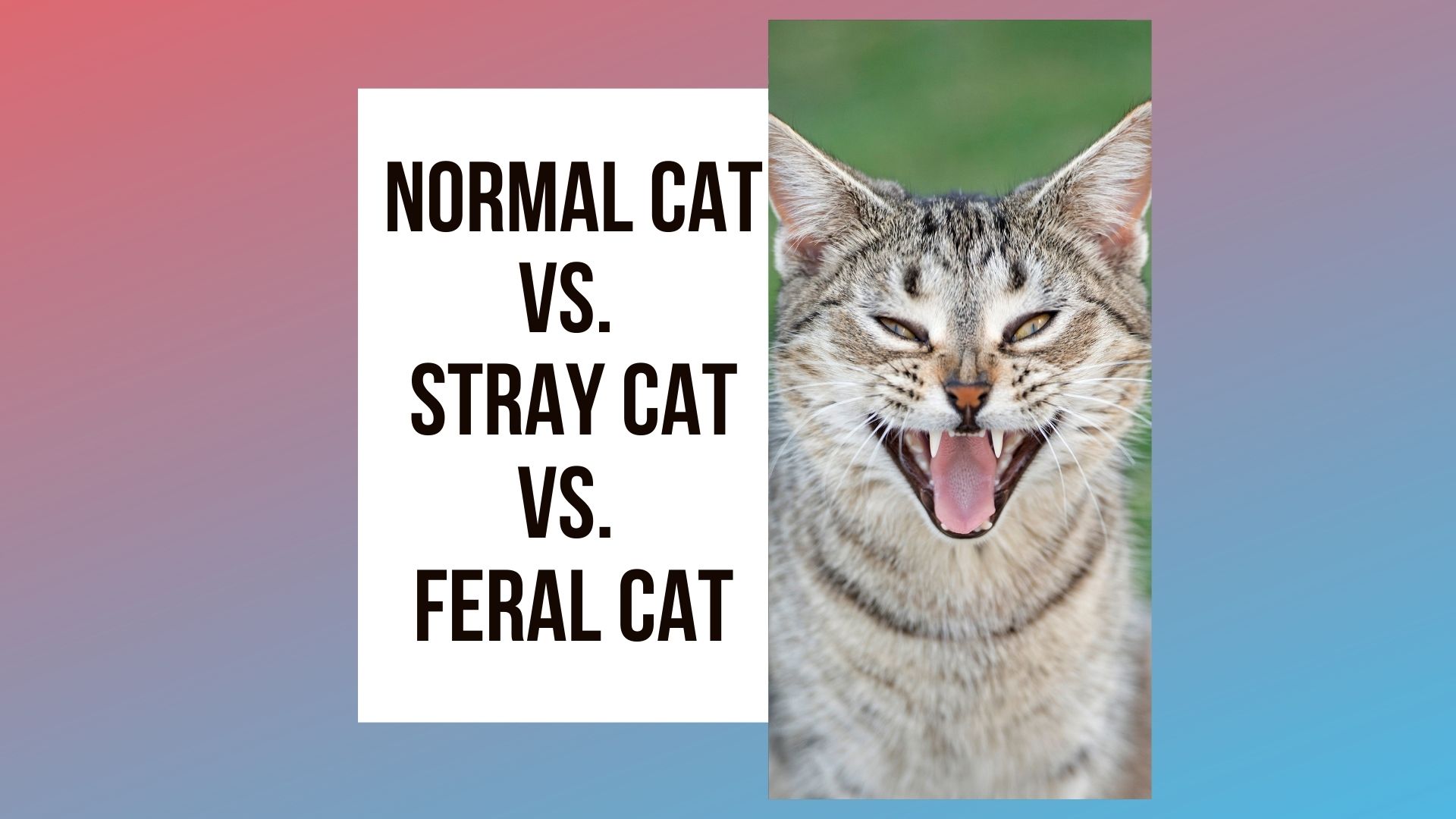
You may be wondering if the new kitty you are suddenly seeing near your home is a feral cat, a lost cat, or a stray cat.
Each of these three types of cats is pretty much the same, but they may act very differently from each other.
Read on to find out how to identify what type of cat you are seeing is it a feral or stray cat?
What is a Feral Cat?
A feral cat is like a domesticated house cat but he is born in the woods and doesn’t interact with humans to be domesticated.
He lives outdoors without any help or consistent care from humans.
Feral cats are usually born in a feral litter from a feral mom and dad or they are born in a litter to stray cats.
Feral cats are not considered to be wild cats or wild animals but they act much differently than other types of cats.
What is a Stray Cat?
A stray cat is one that has had some human care in the past, but it’s not consistent.
It did live near or with humans at one point in time and regularly interacted with them just as a typical house cat does.
It may have actually lived inside with a family or it may have been an outdoor cat with a family to care for it.
At one point in time, if a cat is abandoned by its family or lost and not found, it is considered to be a stray cat because it has no permanent connection with an owner.
What is a Lost Cat?
A lost cat is usually one that was a house cat and it escapes the house and leaves the home or gets lost outside of the home.
Most of the time, the family members will definitely be looking for their lost cat to reconnect with their four-legged feline family member.
You may see signs posted for a lost cat, or it could be wearing a collar and tag with information to find the owners.

What are the Characteristics of Feral Cats?
Feral cats act much like they would be wild cats. They are usually only seen at night, as they are nocturnal and that’s when they hunt for prey for their food. Feral cats usually live in colonies of any size with other feral cats.
A male feral cat usually wonders about 35 acres in distance most times, but some of them can travel up to 740 acres regularly. That’s a lot of travel for a cat.
About 50% of feral cats die within the first year of their life and they usually don’t live past two years at most.
Feral cats may have tipped ears. This is when the pointy part at the top of one ear is removed when it is spayed or neutered and it will be a feral cat. It was most likely part of a trap, neuter, and return procedure so they don’t produce more feral cats.
Feral cats crouch as they walk with their tails down and scan their surroundings, constantly looking for threats.
Normal Cat Vs. Stray Cat Vs. Feral Cat
What are the Characteristics of Stray or Lost cats?
Stray cats and lost cats are much more friendly than feral cats towards humans. This is because they know humans can help them with shelter and food.
A stray cat may be a bit more skittish than a lost cat because it didn’t have human contact consistently as a stray cat did.
However, it also depends on the cat’s personality and the humans it encounters along the way after running away or getting lost or abandoned, as to their attitude.
- Stray cats are usually thinner than feral cats because it’s harder for them to stay full as they once depended on humans to feed them.
- Most Stray cats will often look injured as they are rejected by the feral cat colonies and get into frequent fights with them.
- Stray or lost cats may approach a stranger and even rub on your leg and they will carry their tail upright, which is an invitation to approach them.
How Can You Find Out if a Cat is Feral?
You can actually tell if a cat is feral by watching his actions for several days or at least a week.
- They will usually run away if you start to walk toward them, even if you are 20 yards away from them. humans and human contact scare them and it’s easiest in their minds to run off.
- A feral cat will normally not look you in the eyes. They don’t trust humans, so they avoid eye contact.
- Feral cats don’t normally meow as other cats do, but instead, they hiss and growl loudly or they may caterwaul sounding like a hurt child or woman.
- Loud sounds will make a feral cat run for the hills or woods to escape from it. They are at home in wooded areas and are in tune with the nighttime sounds of crickets and locusts, but other sounds are foreign to them.
- If you put food down for a feral cat and it comes to eat, he will eat a bite or so and look around for predators and repeat this to check his surroundings for safety.
How Do I Approach a Feral or Stray Cat?
If you still aren’t sure if the cat is feral or a stray cat, your best bet is not to get very close to it at all. Cats need space when they are fearful, so they don’t bite or scratch you.
There are some feral cats that are much more friendly to people as they have been fed by them in the past.
If you call the cat, does it come willingly to you or does it come near you when you offer it some food? If so, the cat is most probably not feral.
Does the cat have a collar or tag? If so, it’s either a stray cat or most probably a lost cat.
Ask neighbors if they’ve seen this particular cat and do they know of it about its loss history or having an owner.
Watch for signs that a cat doesn’t want you to approach it. This includes narrowing eyes, hissing, the ears flat on their head, a tail standing straight up and bristling, as well as hair standing up on their backs.
What to Do if You Find a Stray or Lost cat
If you find a cat that is definitely not feral because of its actions and characteristics, you should rescue it. If possible, put it in a secluded room in your home or the garage to keep it contained.
You can feed and water the cat as well as look for a collar and tags to locate the owner. You can feel the skin near the front shoulders for a chip in them and then take them to a vet to read their chip, find their family and return their cat to them.
Check in the neighborhood for lost cat signs and websites in your area for lost and found pets. Post the cat as a found cat. A vet’s office can direct you to the websites to help you.
You can return the cat to the rightful owner if you find it, call a nearby rescue to take him in, or adopt him yourself.
Can I Tame a Feral Cat?
Some avid animal lovers have successfully tamed feral cats and gone on to domesticate them and have them as family pets.
Mostly they are outside cats, but a few people have made them into great indoor pets as well. The process takes a lot of time and patience.
The younger the cat and the better its personality will make it an easier project than an older cat that never had human contact.
Food is your feline friend.
You can set out some cat food near where you see the cat, but not close to your home. He will feel more secure nearer to his home or den.
Each day, give him more food and fresh water and move it about 6 to 12 inches closer to your house each day.
You need to offer the food at the same time each day so the cat learns your routine and can anticipate it.
When your feeding area is getting pretty close to your home, you can start talking to the cat in a very calm voice. Avoid making eye contact with the cat or making any sudden movements.
Eventually, you may be able to reach out and touch the cat lightly. If it backs away, wait several days until trying this again. Eventually, you will be able to pet him and pick him up.
At this point, you can put the cat in a crate and take him to the vet for a checkup and any medication he may need. You can then decide if you want him to be an inside or outside cat as your new family member.
- For Further Reading
- How to Tell When a Cat is Ready to Give Birth?
- Can You Use Baby Shampoo on Cats, and Is It Often a Safe Choice?
- How Many Teeth Do Cats Have: Expectations As Your Kitten Grows Up
Summary
Keep in mind that some feral cats are never tameable enough to be a house cat and always be cautious of them;
when you are trying to tame them. You may just have found your new best friend that took a lot of hard work to find and tame.

Hi, This is Alexa, and I love cats. This Website is a Complete Journal about how to travel with a cat and other information about Cat Health, Cat Training, Cat Behavior, Cat Foods and more. I hope you find it useful.
